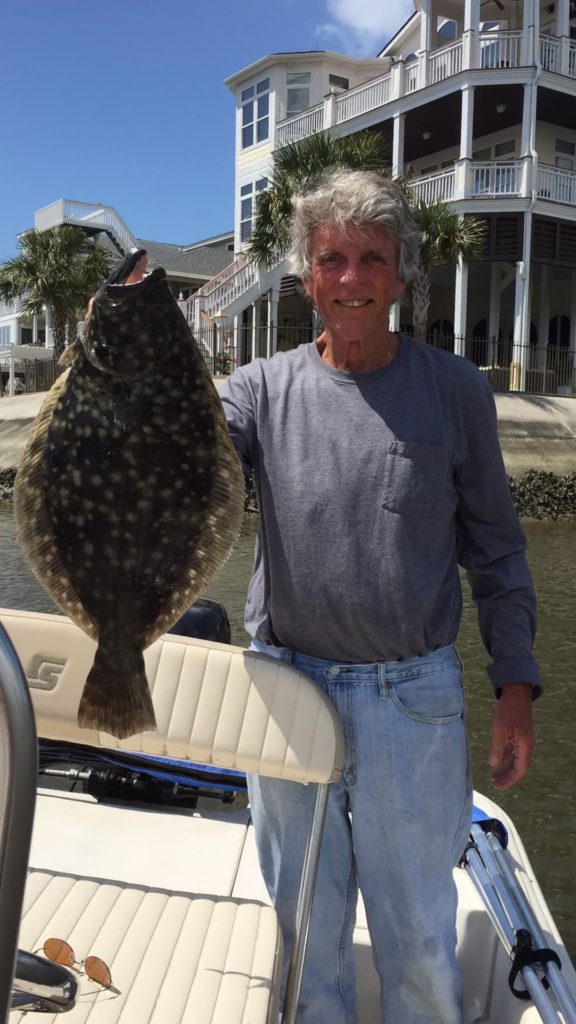Ocean Isle – June 7, 2018
Jeff, of Ocean Isle Fishing Center, reports that some nice red drum are being found by fishing oyster beds with live menhaden or fiddler crabs. Good-sized flounder are hitting around Tubbs Inlet, and even though the mullet in the area are still a little small, mud minnows will do a great job at catching fish. The flounder would usually be in the Shallotte River this time of year, but muddy conditions due to the rain are making them hard to find.
There have still been no speckled trout to really speak of, which could be due to the distinct lack of bait shrimp in the area. A few have been caught at the jetties and other areas close by, so expect them to move in soon.
The sheepshead bite is great right now, especially around the Ocean Isle Bridge and the docks around Shallotte Inlet. Send down live fiddler crabs to get a hit.
Brant, of Ocean Isle Fishing Center, reports that spanish fishing has been good on the beach, as has shark fishing. Blacktips are the most common shark, but others can be found as well.
King fishing for school fish has been very good, with kings in the 6-10 lb. range biting in 55-70’ of water. Big 20+ lb. fish are starting to filter in from the south and can be caught between 65-120’, but it’s almost like finding a needle in a haystack. Trolling dead cigar minnows will help find a king no matter the size.
Gulf Stream fishing is slow, particularly because the dolphin bite has dropped off quite a bit. At this point, the best bet for finding the mahi is to put bait down to 100 fathoms or more. Blue marlin are around as well.
Bottom fishing has been productive in the 90-120’ range, where the main story is American red snapper. Regulations are starting to free up around these fish, especially since there are more of them around now than have been seen in 25 years. Pay attention to the dates that you’re allowed to fish for them, and make sure to send some bait down when you can. If you don’t find one, plenty of scamps will be there to bite.

Mike Morris, of Ocean Isle Beach, with a 6.3 lb. flounder that fell for a Hookup Lures bucktail in a canal near Ocean Isle.
Kevin, of Rigged and Ready Charters, reports that kings in the 15 lb. range are being caught around the Shark Hole and the Jungle. Slow trolling dead cigar minnows is sure to get a bite.
Cobia are thick and can be easily caught on live menhaden when you find a school of the baitfish. Catching pogies and cobia at one time while anchored in the same spot is not only possible, but a great way to get a big bite.
There have been a plethora of spadefish around nearshore ARs, where chumming heavy and using a small spinning rod to drop Native Salt Clams on a 25 lb. fluorocarbon leader will get a bite.
Tripp, of Capt’n Hook Outdoors, reports that inshore, the redfish bite has been steady, with most fish in the 20-25” range. The reds are mostly biting live pogies and crabs around docks or structure.
The black drum bite has slowed, but some fish in the 15-17” range can still be found. They are mainly biting live and fresh cut shrimp on Carolina rigs.
Flounder in the 14-18” range are readily biting. Most of the bigger fish are taking pogies, while the smaller flatties are typically biting mud minnows. Carolina rigs are the key here.
Offshore, the cobia bite has been strong around the 10 mile wrecks, with most of the fish weighing between 30-50 lbs. They are eating live pogies, live eels, and bucktails.
King mackerel have shown up in full force between 10-40 miles on live bottom and around area wrecks. Most of the fish have been between 10-15 lbs., but bigger ones are out there as well.
The grouper bite has been mediocre, but the fish that are being caught are hanging in the 150-175’ range. Live pinfish are proving to be the best bait.

Brian Richard with a 20 lb. gag grouper that hit a dead cigar minnow in 170′ of water. He was fishing with Capt. Tripp Hooks of Captn’ Hook Outdoors.
Tim, of Tideline Charters, reports that the flounder bite has been good, with both keepers and smaller fish in the mix. To find them, fish mud minnows on Carolina rigs in deeper holes or around structure (where a pearl white or nuclear chicken Gulp on a jig head may work as well).
Red drum are being found in the same areas as the flounder, though changing things up based on the tide may increase your chances of catching one. Vudu shrimp fished on the bottom is best for finding big fish (22-25”) at low tide, while suspending Vudu shrimp under a popping cork along the grass line works better at high tide, though the reds will be smaller (18-20”).
Stewart, of Rod and Reel Shop, reports that a little bit of everything is biting, with red drum and flounder being the most cooperative inshore.
Off the beach, the name of the game is finding clean water. Once you do, there are plenty of big bluefish, spanish, and kings to be caught.
Bob, of Ocean Isle Beach Fishing Pier, reports good catches of whiting and bluefish. The bluefish are hitting on Gotcha plugs or any kind of cut bait.
A few spadefish and black drum have also been caught by anglers using shrimp, and a handful of sandbar sharks have been in the mix as well.
